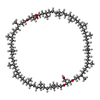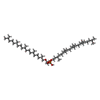+Search query
-Structure paper
| Title | Archaeal DNA-import apparatus is homologous to bacterial conjugation machinery. |
|---|---|
| Journal, issue, pages | Nat Commun, Vol. 14, Issue 1, Page 666, Year 2023 |
| Publish date | Feb 7, 2023 |
 Authors Authors | Leticia C Beltran / Virginija Cvirkaite-Krupovic / Jessalyn Miller / Fengbin Wang / Mark A B Kreutzberger / Jonasz B Patkowski / Tiago R D Costa / Stefan Schouten / Ilya Levental / Vincent P Conticello / Edward H Egelman / Mart Krupovic /     |
| PubMed Abstract | Conjugation is a major mechanism of horizontal gene transfer promoting the spread of antibiotic resistance among human pathogens. It involves establishing a junction between a donor and a recipient ...Conjugation is a major mechanism of horizontal gene transfer promoting the spread of antibiotic resistance among human pathogens. It involves establishing a junction between a donor and a recipient cell via an extracellular appendage known as the mating pilus. In bacteria, the conjugation machinery is encoded by plasmids or transposons and typically mediates the transfer of cognate mobile genetic elements. Much less is known about conjugation in archaea. Here, we determine atomic structures by cryo-electron microscopy of three conjugative pili, two from hyperthermophilic archaea (Aeropyrum pernix and Pyrobaculum calidifontis) and one encoded by the Ti plasmid of the bacterium Agrobacterium tumefaciens, and show that the archaeal pili are homologous to bacterial mating pili. However, the archaeal conjugation machinery, known as Ced, has been 'domesticated', that is, the genes for the conjugation machinery are encoded on the chromosome rather than on mobile genetic elements, and mediates the transfer of cellular DNA. |
 External links External links |  Nat Commun / Nat Commun /  PubMed:36750723 / PubMed:36750723 /  PubMed Central PubMed Central |
| Methods | EM (helical sym.) |
| Resolution | 3.44 - 4.1 Å |
| Structure data | EMDB-27413, PDB-8dft: EMDB-27414, PDB-8dfu: EMDB-28657, PDB-8exh: |
| Chemicals |  ChemComp-TT0:  ChemComp-RHR:  ChemComp-X3D: |
| Source |
|
 Keywords Keywords | PROTEIN FIBRIL / archaeal conjugative pilus / Archaeal conjugation pilus / T-pilus |
 Movie
Movie Controller
Controller Structure viewers
Structure viewers About Yorodumi Papers
About Yorodumi Papers











 pyrobaculum calidifontis (archaea)
pyrobaculum calidifontis (archaea) Agrobacterium fabrum str. C58 (bacteria)
Agrobacterium fabrum str. C58 (bacteria)